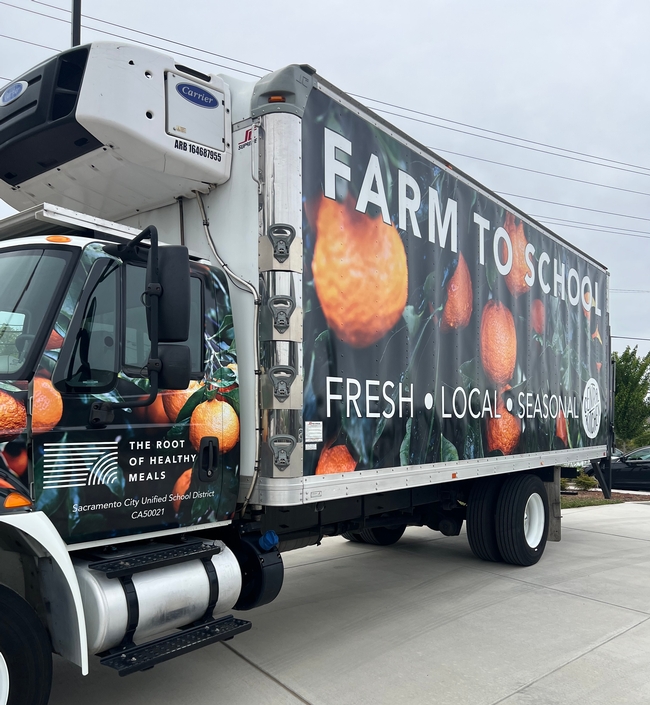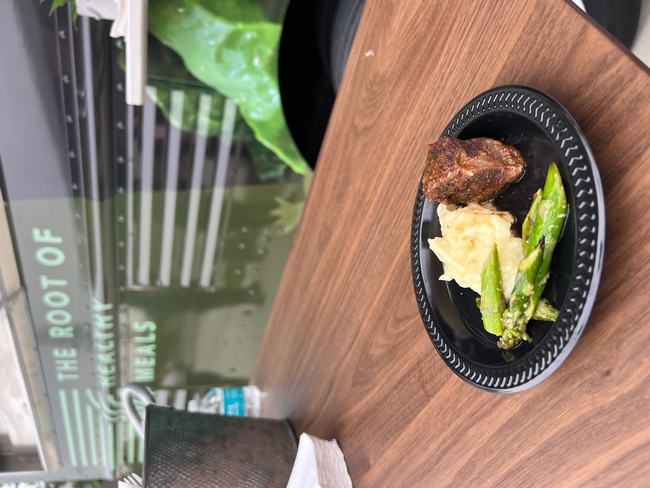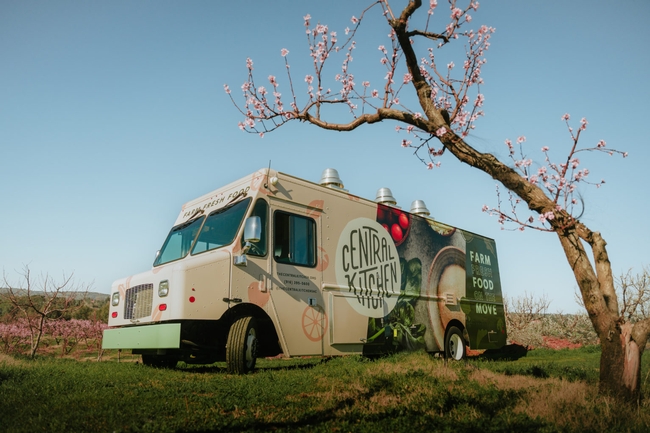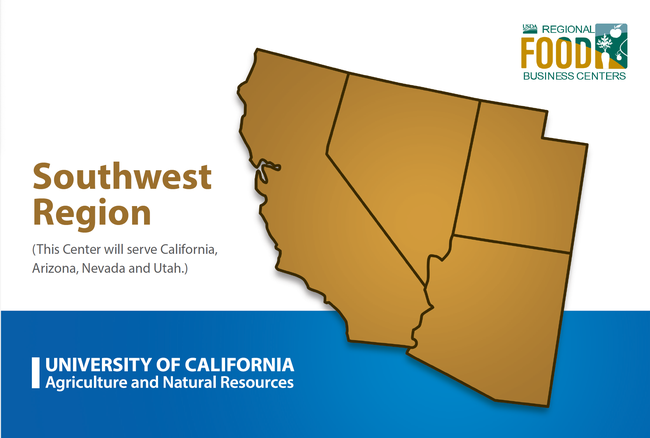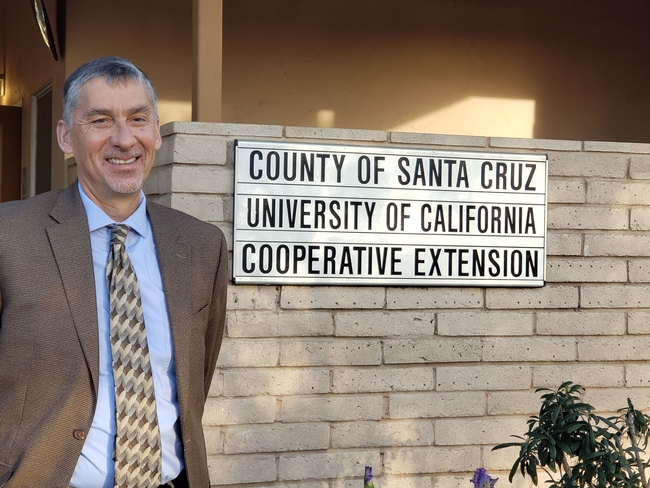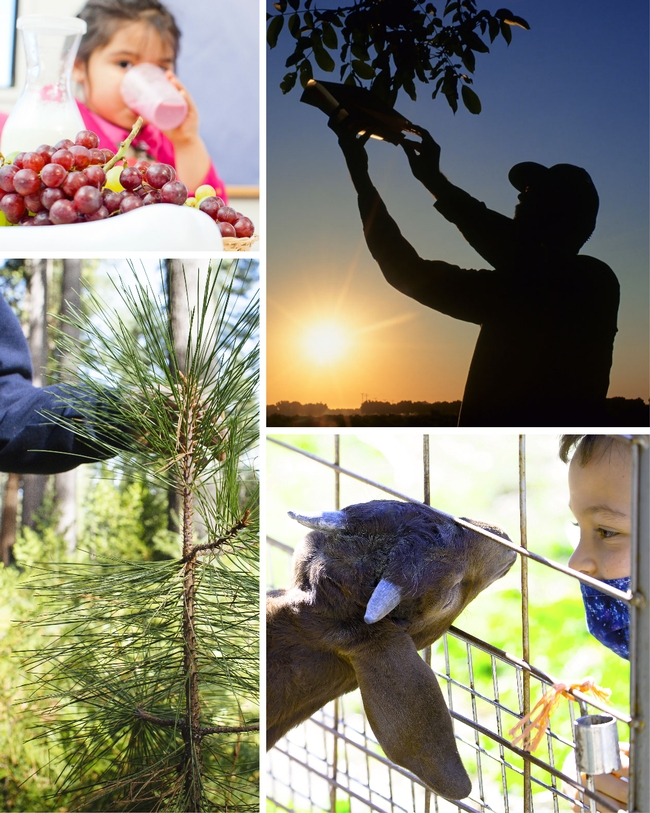- (Public Value) UCANR: Promoting healthy people and communities
- Author: Michael Hsu
New Cooperative Extension director has worked extensively with Native American communities, youth groups
Growing up in Upper Lake, along the “North Shore” of Clear Lake, Matthew Barnes lived near several of the Lake County region's seven federally recognized tribes. Although he counted several Native Americans among his diverse circle of childhood friends, and was very familiar with those communities, Barnes was nonetheless quite nervous when he was appointed in 2009 as the inaugural executive director of the Boys & Girls Club of the Pomo Nation.
Barnes – a non-Native of European and Filipino descent – vividly remembers the tribal administrator paying him a visit on one of his first days on the job. “He said, ‘Hey, you have two ears and one mouth, so listen twice as much as you speak and you'll be fine,'” Barnes recalled. “And that's definitely stuck with me.”
That approach is continuing to guide Barnes in his new role as University of California Cooperative Extension director for Lake and Mendocino counties. He will guide and support research, outreach and education activities to meet the area's agriculture, natural resources, and youth and community development needs.
Since starting in May, Barnes has been getting a crash course from UCCE advisors and staff on viticulture research, pest management practices, 4-H camps, and a host of other projects and programs – while also meeting with local communities on the region's most pressing challenges.
“What I've been doing – and will continue to do – is just to listen and learn, and when I can add value to a conversation or project, then I'll do that,” Barnes said. “But leadership to me starts with the relationships we build – with our staff and with the community.”
Bringing a range of experiences in youth programs, social services
One area in which Barnes will certainly add value is developing youth and community programs. During his time with Boys & Girls Club of the Pomo Nation, it was one of only three Boys & Girls Clubs established on tribal land in California. In that role, Barnes faced the unique challenge of integrating the Boys & Girls Club curriculum into a community for which it was not originally designed.
By adapting the curriculum to include culturally relevant topics, Barnes transformed the program into a model that eventually aided in the creation of a Native American-focused branch, Boys & Girls Clubs of America Native Services.
“This initiative now serves as a national standard for Boys & Girls Clubs on tribal lands,” Barnes said.
He later became a director of California Tribal TANF (Temporary Assistance for Needy Families), a direct cash assistance and supportive services program for Native American families in 17 counties across the state.
During his decade of TANF work, Barnes launched career development programs, alcohol and other drug counseling programs, and cultural revitalization initiatives. Some of the programs are still running and serving communities to this day.
“The trick is making those programs something that participants can see the value in,” Barnes explained. “And to do that, you go into the communities and talk to people and listen to what they need – instead of you telling them what they need.”
Barnes' experience partnering with Native American communities is just one of the many strengths he will bring to UCCE and UC Agriculture and Natural Resources.
“We're very excited to have Matthew join the UC ANR family,” said Lynn Schmitt-McQuitty, UC ANR's director of County Cooperative Extension. “His personal knowledge of Lake and Mendocino counties and his previous work with Indigenous populations will be a tremendous asset to extending and elevating our work.”
Immediately prior to joining UC ANR, Barnes served as director of Lake County's Upward Bound program, which helps students from three local high schools experience and prepare for higher education.
“Overall, what drives me personally is the opportunity to make an impact on communities, on youth, and on people in general through program development and management,” Barnes said.
Inspiring young people as a mentor
Barnes' passion for youth development – and the impetus for his bachelor's degree in social work from Cal Poly Humboldt – can be traced to his AmeriCorps experience while he was attending Mendocino College. For two years, he worked as a tutor for young people, in Lake County and then in Sonoma County, and saw firsthand the difference educators and mentors can make in their lives.
“You could say I kind of caught the bug – just seeing the light bulbs go on when you're helping a youth of that age,” Barnes said.
From there, Barnes took a position directing teen programs for the Boys and Girls Club of Healdsburg, where he began to fully appreciate the importance of trusted adults simply “being there” for young people as a listening ear for whatever they want to talk about.
Among the many teens Barnes worked with, “Rodrigo” was a middle schooler who was pegged by his school and community as someone who could “slip through the cracks.” Rodrigo was the last to go home at the end of each day, and Barnes would chat with him – answering his questions about life or just talking about a new rap album.
“I realized I was ‘that person' for him – that person outside his house, outside his school,” Barnes said.
Even after Barnes left the Boys and Girls Club, Rodrigo – bound for university – invited him to his high school graduation. Barnes said it is tremendously gratifying to know he had a “small role” in shaping the path for Rodrigo – and countless others.
“Their success is still theirs; it's not necessarily because of me,” Barnes added. “My job is to do what I can in the moment to hopefully plant some seeds that may sprout in the future.”
Settled in Middletown, not far from his hometown, where he and his wife are raising two children, Barnes is now positioned to help nurture a flourishing Lake County and resilient Mendocino County.
“I feel like my past experiences, both in life and my career, have prepared me for this,” Barnes said.
- Author: Pamela Kan-Rice
The U.S. Department of Agriculture has announced selections for the USDA Regional Food Business Centers. Twelve organizations, including University of California Agriculture and Natural Resources, have been selected to establish Regional Food Centers that will provide coordination, technical assistance and capacity building to help farmers, ranchers, and other food businesses access new markets and navigate federal, state and local resources, thereby closing the gaps to success.
In September 2022, USDA announced $400 million available to fund this initiative. In total, USDA will establish 12 Regional Food Business Centers that will serve all areas of the country, including U.S. territories. Regional Food Centers will target their work to historically underinvested communities in their region.
USDA and University of California Agriculture and Natural Resources will enter into a cooperative agreement to establish a Southwest USDA Regional Food Business Center that will serve California, Arizona, Nevada and Utah. The $35 million project will have a particular focus on the Colonias communities – communities within the mainly rural U.S.-Mexico border region with marginal conditions related to housing and infrastructure – of southern Arizona and California. (See Colonia-Community-Map at hudexchange.info.)
“USDA is excited to be partnering with the UC ANR on this innovative and unprecedented initiative,” said Jenny Lester Moffitt, USDA under secretary for marketing and regulatory programs. “By leveraging the expertise now available through these Regional Food Centers, USDA can offer unique support for local food systems development across the country.”
UC ANR will primarily serve to coordinate technical assistance offerings across the multi-state region, managing the timing, frequency and delivery of the Southwest USDA Regional Food Business Center's overall portfolio of technical assistance providers, educational courses, workshops and trainings to reduce the potential for competing and duplicated content.
“It is so exciting to see 16 organizations, across four states, coming together with us to enhance and expand much-needed business support services to our food and farm businesses,” said Glenda Humiston, University of California vice president for agriculture and natural resources.
“Our strategy of quickly scaling existing successful programs offers quick returns on this investment, as does a focus on ensuring service for disadvantaged and historically underrepresented communities of producers, farmers and agrifood businesses.”
Collectively, the organizations selected reflect an impressive cross-section of the varied institutions, organizations and associations that must cooperate to achieve genuinely strong and distributed food systems. UC ANR and the other selected organizations are already engaging with grassroots food and farm organizations and employing a range of creative strategies to build food system resiliency in their regions.
The University of California will provide technical assistance throughout the state through its Cooperative Extension programs, consisting of the Small Farms Program, Regional Food Systems, Urban Agriculture Program, Community and Economic Development Network, and UC campus-based subject matter experts covering food safety, economics and cooperatives.
Partners include California Department of Food and Agriculture; California State University – Chico; California State University – Fresno; Occidental College; Riverside Food System Alliance; San Diego Food System Alliance; UC Santa Cruz; UC Davis; Valley Vision; Arizona Department of Agriculture; Local First Arizona Foundation; University of Arizona; Nevada Department of Agriculture; University of Nevada – Reno; Utah Department of Agriculture and Food; and Utah State University.
Collaborators include Community Alliance with Family Farmers, Center for Good Food Purchasing, Agriculture & Land-based Training Association, Prosperity Market, Farmer Ken, California FarmLink, BAR-C, The Farmers Marketplace, Lost Sierra Food Project, Northern California Chamber of Commerce, 3CORE, Chico-based consulting firm Morrison, Glenn County Resource Conservation District, Kitchen Table Advisors, Diaspora Groceries, The Larta Institute, Los Angeles County Food Equity Roundtable, Los Angeles Food Policy Council, Sustainable Economic Enterprises of Los Angeles, Growing Communities Inc., Health Care Without Harm, Community Investment Corp, Pinnacle Prevention, Arizona State University, White Mountain Economic Development, Food Bank of Northern Nevada, Nevada Farm Bureau Federation, Zion United Methodist Church, Reno Food Systems, Three Square, Blue Lizard Farms, Garden Farms of Nevada, Churchill Entrepreneur Development Association, UNR Desert Farming Initiative, Utah Farm Bureau, International Rescue Committee in Salt Lake City, Utah Small Business Development Centers, and Utah Cattlemen's Association.
More information is available on the Agricultural Marketing Service's Regional Food Business Centers webpage: https://www.ams.usda.gov/services/local-regional/rfbcp.
- Author: Pamela Kan-Rice
- Author: Mike Hsu
- Author: Saoi Sope
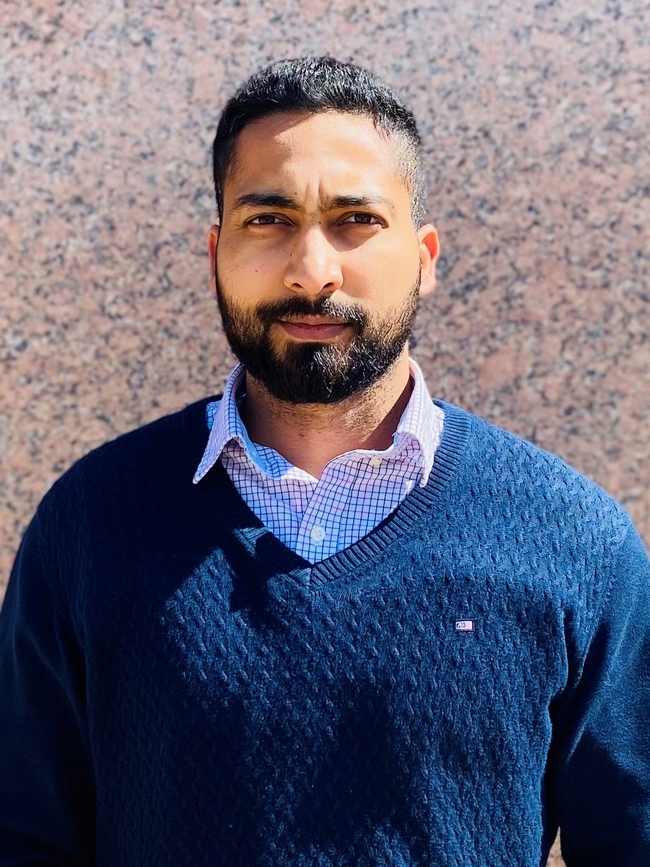
UC Cooperative Extension advisors work directly with community members to apply research-based information to improve the lives and livelihoods of Californians.
To see a list of UC Cooperative Extension advisors who have joined in the past few months, visit https://ucanr.edu/About/DirectorySearch/Recent_Hires. The most recently hired advisors are introduced below.
Singh named UCCE tech and innovations advisor for small farms
Manpreet Singh began working on Feb. 15 as a UC Cooperative Extension technology and innovation advisor for small farms and serves Fresno, Kings, Tulare, Madera and Merced counties.
Singh is responsible for testing and evaluating new technologies that can resolve challenges that small farms experience. With a variety of technological advancements becoming available, Singh will help small farms determine the feasibility and economic impact of their options. His role will not only prioritize crop production efficiency, but post-harvest and marketing of crops as well.
A few areas of concern that are top of mind for Singh are weed control and water efficiency. “Weed control is a major part of agricultural operations and a logistical nightmare,” he said. “Since I did a lot of research in irrigation, I also want to help small farms adapt to smart irrigation controllers.”
Singh earned a master's in horticulture, specializing in vegetable science, and a bachelor's in agriculture from Punjab Agricultural University in India. During his master's program, Singh focused his research on hybrid breeding of melons.
After completing his master's, he moved to the United States to join the Ph.D. program at Texas Tech University where he worked as a teaching assistant for Principles of Horticulture labs. His Ph.D. research focused on limited irrigation strategies for vegetable production in West Texas.
“In the past, I did some extension work, but I never had a chance to work directly with the farmers. I'm ready to do some applied research that involves the farmers. So, this job provides me a great opportunity to do those things,” said Singh.
Singh is based out of the Kearney Agricultural Research and Extension Center and can be reached at mansing@ucanr.edu.
Ott to advise growers in Tehama, Butte, Shasta and Glenn counties 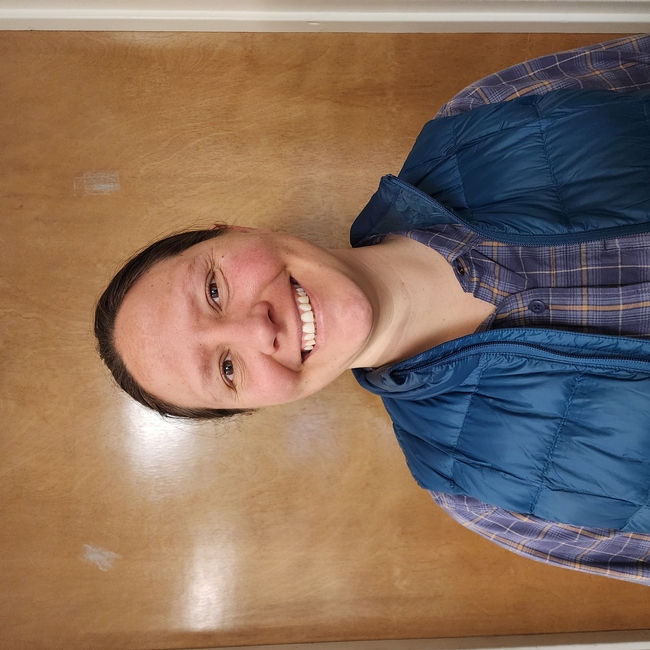
Since the beginning of this year, Jaime Ott has been settling in at UC ANR as the new UC Cooperative Extension orchard systems advisor for Tehama, Butte, Shasta and Glenn counties.
“Officially I am covering walnut, prune, almond and olive in these counties,” Ott said. “But since there is only one other advisor in my office, Josh Davy, the joke is that he covers anything with feathers, fins and fur – and I cover anything with chlorophyll.”
Ott said she hopes to help California agriculture become more robust, profitable and sustainable – economically, socially and environmentally – far into the future.
“I want to help serve as a bridge, communicating the needs of the growers in my area to the researchers on UC campuses to make sure that we are doing the right research, research that will help to move our production systems forward,” she explained.
After growing up in El Dorado County, Ott earned her undergraduate degree in biological sciences from UC Davis. She received her M.S in marine science from the College of William & Mary, and then joined the Peace Corps, through which she worked with farmers in Zambia to raise tilapia.
Since returning from Africa in 2014, Ott has been working in the lab of Greg Browne at UC Davis and pursuing her Ph.D. in the Department of Plant Pathology. Her research has focused on which Phytophthora species are affecting almonds and walnuts in California and the ways the pathogen is introduced into orchards.
“My experience in Zambia really highlighted how powerful information can be, and I want to make sure that California growers have access to all of the practical information that UC and UC Cooperative Extension scientists are generating,” she said.
Ott, based at the UCCE office in Red Bluff, can be reached at njott@ucanr.edu and (530) 527-3101.
Justin Tanner joins UCCE as grape advisor 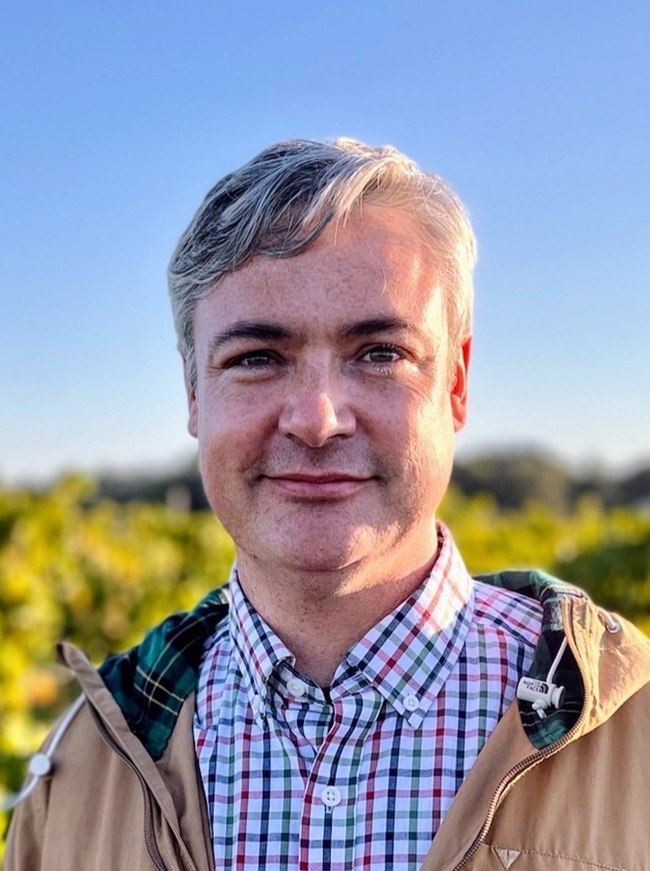
Justin Tanner joined UC ANR on Jan. 3 as a UC Cooperative Extension viticulture advisor for San Joaquin, Stanislaus and southern Sacramento counties.
Tanner is responsible for implementing an innovative extension education and applied research program to address high-priority production issues in wine and table grapes including pest, disease, and water management.
Specifically, he supports entry-level growers who are seeking basic viticulture and pest management practices, while providing experienced growers information on new technologies to remain competitive. All producers face mounting pressures from increased regulatory and environmental compliance requirements as well as cost-competitiveness in an increasingly global marketplace.
Tanner attended Colorado State University and earned a Ph.D. in horticulture, focusing on germplasm conservation of temperate fruit trees. He also attended Texas A&M University, where he earned a master's degree in horticulture for citrus virology, as well as a bachelor's degree in agriculture for environmental soil science.
As a postdoctoral scholar in the Department of Viticulture and Enology at UC Davis, Tanner designed and implemented research projects at Oakville Station in Napa County. During his time there, he investigated various factors that affect wine grape production such as examining the effects of cluster thinning and irrigation practices on grapevine red blotch virus-positive vines to evaluate the efficacy of cultural management practices on mitigating virus impact on grape quality and yield. He also conducted trials to identify rootstock and scion combinations as well as trellis systems to optimize production under warming climate conditions.
To understand the needs and challenges of the growers he supports, Tanner is working closely with growers, industry leaders, the Lodi Winegrape Commission and pest control advisers in the region.
“I see the spread of grapevine leafroll-associated virus by the vine mealybug as a huge challenge for grape growers within San Joaquin and Stanislaus counties,” said Tanner. “As vine mealybug reproduces prolifically and spreads easily, controlling this invasive pest will require an integrated pest management approach with a concerted and sustained effort at the community level.”
Tanner is excited to contribute to the success of grape growers and the wine industry using a science-based approach. “The growers and pest control advisers I have already had the opportunity to meet with have been kind, intelligent and hardworking people who I enjoy working with,” he said.
Tanner is based out of the UCCE San Joaquin County office in Stockton and can be reached at jdtanner@ucanr.edu.
Kayad named ag engineering advisor at Intermountain REC 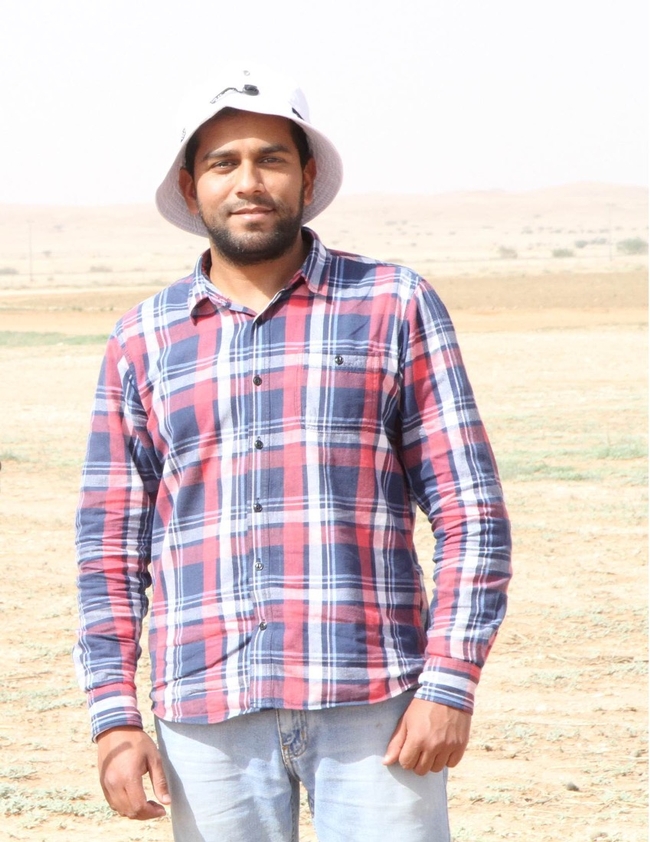
Ahmed Kayad joined UC Cooperative Extension in January as an agricultural engineering advisor at the Intermountain Research and Extension Center.
He will address regional needs in relation to integrating and adapting new technologies related to mechanization, automation and precision agriculture into intermountain cropping systems. Kayad is eager to investigate differences in crop growth and development within agricultural fields in Modoc and Siskiyou counties using satellite, drone and ground sensors.
To help farmers make informed management decisions across their farming operations, one of Kayad's first objectives is to map fields for spatial and temporal yield variability to better understand management practices that increase crop production.
Prior to joining IREC, Kayad was a postdoctoral researcher at UC Riverside. His recent research activities include monitoring crop yield through ground and remote sensing for alfalfa and corn, using drone images for weed detection in vegetable crops, and investigating the impact of digital solutions in agriculture. He worked as a service engineer at farm equipment manufacturer CLAAS in Egypt, specializing in hay balers and forage/grain combine harvesters. In 2020, he was a visiting doctoral researcher at the International Maize and Wheat Improvement Center in Mexico.
Kayad earned a Ph.D in digital agriculture from the University of Padua, Italy, studying corn yield mapping through ground and remote sensing techniques. He earned a bachelor's and master's in agricultural engineering from Alexandria University, Egypt and King Saud University, Saudi Arabia respectively.
Kayad is located at the Intermountain Research and Extension Center in Tulelake and can be reached at agkayad@ucanr.edu and (530) 667-5117.
Eddie Tanner named UCCE specialty crops and horticulture advisor 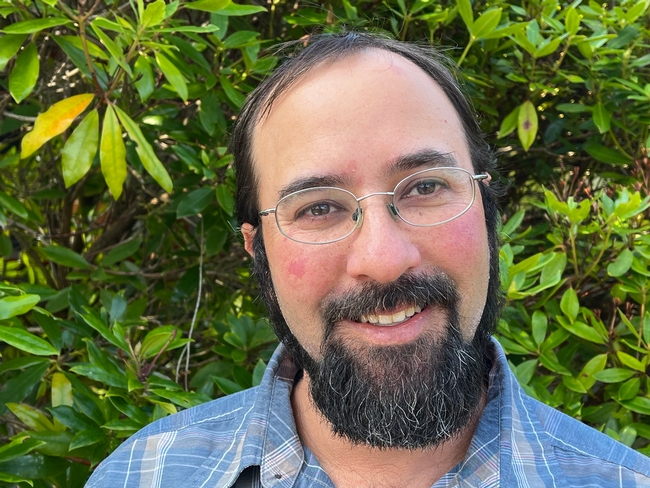
Eddie Tanner joined UC Cooperative Extension on Jan. 3 as a specialty crops and horticulture advisor serving Humboldt and Del Norte counties.
He will be supporting the region's vegetable, fruit, flower and nursery growers with research-based technical assistance, collaborating with community partners to increase access to locally produced foods, and supporting the UC Master Gardeners.
Tanner has been involved in agriculture in Humboldt County for over 20 years as a farmer and a farm and garden educator. He holds a B.S. in wildland soil science from Humboldt State University and an M.S. in agriculture from Washington State University.
Tanner is based in the Eureka office and can be reached at ehtanner@ucanr.edu.
Gilani named biomass and bioenergy advisor 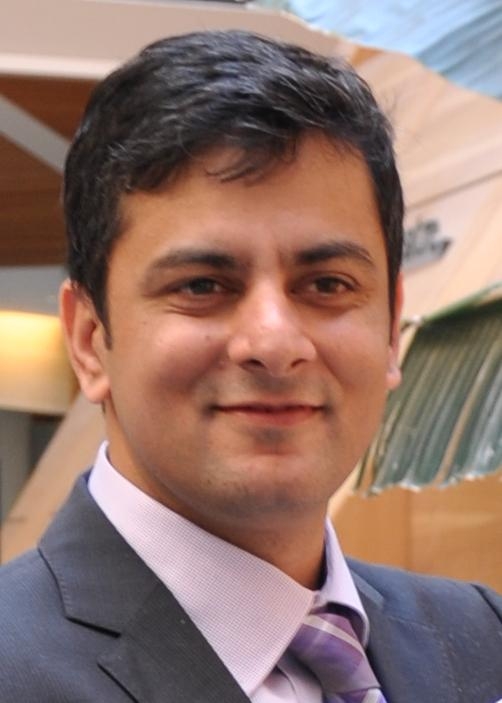
Haris Gilani joined UC ANR on Jan. 9 as a UCCE biomass and bioenergy advisor serving Riverside and San Bernardino counties.
In this role, Gilani investigates opportunities and strategies for increasing the use of woody biomass through development of biofuels and bioenergy among other products. He will also work to enhance biomass management and natural resource manufacturing with strategies for reducing community risk from wildfires.
“I think the overarching aim is to develop sustainable markets for wood and biomass to support forest management and restoration activities across all forest lands in California,” Gilani said. “This will help achieve the state's climate change goals as well as promote long-term economic development and community resilience.”
Another important aspect of his role is communicating research-based information on efficacy of converting woody biomass into fuels for transportation and other products that are consistent with the state's Forest Carbon Plan, to the public, industry, government and relevant stakeholders.
Gilani earned a Ph.D. in forest products marketing from the University of British Columbia, Canada, a Master of Business Administration from Technical University Freiberg in Germany, and a bachelor's in mathematics and physics from the University of the Punjab in Pakistan.
Before joining UC ANR, Gilani worked at his alma matter in Canada as a postdoctoral fellow focusing on economic and market analysis of value-added wood products in BC. He also worked as an assistant project scientist at UC Berkeley researching biofuels, before he joined the State University of New York in Syracuse, where he developed a wood-based bioeconomy roadmap for NY State.
Gilani is based out of the UCCE Riverside County office in Palm Desert and can be reached at hgilani@ucanr.edu.
Nguyen named UCCE nutrition specialist 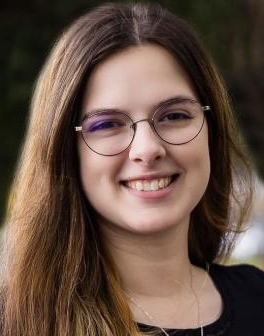
Cassandra Nguyen joined UC Cooperative Extension on Jan. 3 as a specialist in the UC Davis Department of Nutrition.
Nguyen's long-term goal is to bridge the gap between "what we know" and "what we do" about food insecurity. Her research encompasses three areas of interest: revitalization of local food systems to increase diet quality and well-being among Native communities and families; integration of food insecurity screening into healthcare services to better address chronic diseases; and advancements in the charitable food system to increase equity and empowerment of clients.
Nguyen recently published a journal article on food bank strategies to promote nutrition and health.
She earned a Ph.D. in human nutrition and M.S. in nutritional sciences, both from the University of Illinois at Urbana-Champaign and a B.S. in dietetics from Central Washington University.
Nguyen is located in Meyer Hall at UC Davis and can be reached at (530) 752-3817 and casnguy@ucdavis.edu.
Engelskirchen shifts to new sustainable agriculture role 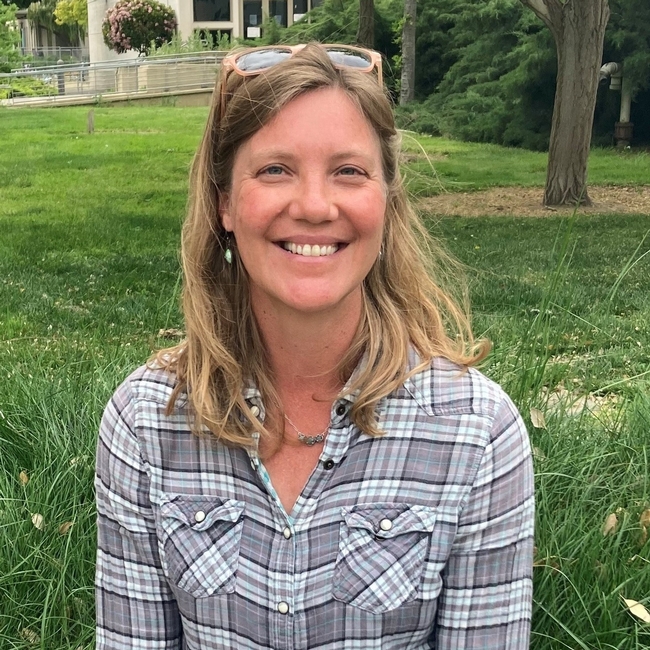
Gwenaël Engelskirchen began as the new sustainable food and farming coordinator with the UC Sustainable Agriculture Research and Education Program in January.
After serving as SAREP's sustainable supply chain coordinator since 2015, Engelskirchen said she is looking forward to her new role as an academic coordinator to support farmers and ranchers in adopting more sustainable agricultural practices while strengthening regional food systems.
“Leveraging SAREP's emphasis and expertise on sustainability from ‘farm to fork,' I hope to bring research and resources to meet the needs of diverse clientele groups across California,” Engelskirchen said.
Key audiences and partners include agricultural producers, regional distributors, food hubs, institutional and retail buyers, community organizations and agencies that address food, farming and natural resource issues. In her previous capacity with SAREP, Engelskirchen launched the California Food Hub Network, a statewide learning network for regional, values-based food distributors.
In addition to earning bachelor's degrees in international development and women's studies from UCLA and a master's in community development from UC Davis, Engelskirchen has worked on and managed organic farms, both urban and rural. She has designed and organized workshops, field walks, webinars and educational events and delivered direct technical assistance for farmers in California and Arizona.
“I am continually drawing inspiration from my colleagues, collaborators, community and the land,” she said.
Engelskirchen is based at the UC ANR building in Davis and can be reached at gaengelskirchen@ucanr.edu and (530) 792-8253.
Baddorf joins SAREP as sustainable supply chain coordinator 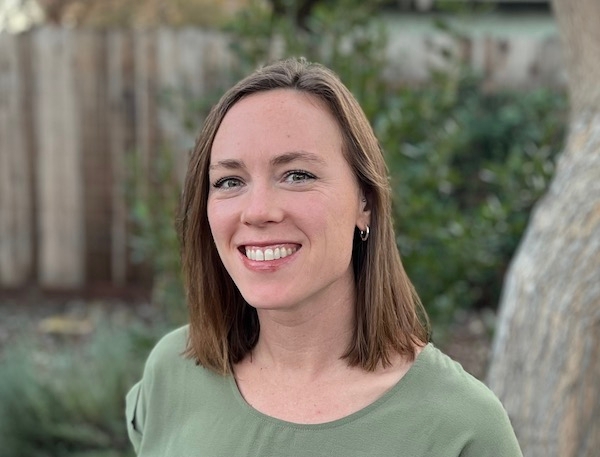
Alicia Baddorf joined the UC Sustainable Agriculture Research and Education Program on Feb. 1 as the new sustainable supply chain coordinator. She succeeds Gwenaël Engelskirchen, who is now SAREP's sustainable food and farming coordinator.
Baddorf brings over 10 years of sustainable agriculture and regional food systems experience to UC SAREP. Her research broadly aims to support farmers and ranchers in adopting more sustainable agricultural practices and assist communities in building equitable and healthy regional food systems.
She has experience with farms and food hubs, including educational program development, farming and the management of sales, community-supported agriculture programs, and marketing. With the Community Alliance with Family Farmers, she advised small-scale farmers finding right-fit technologies to expand their marketing opportunities.
She holds dual bachelor's degrees in sociology and French studies from the University of Delaware and is currently pursuing a master's degree in community development from UC Davis.
Baddorf is based at the UC ANR building in Davis and can be reached at akbaddorf@ucanr.edu.
Oker named soils and irrigation advisor for Kern County 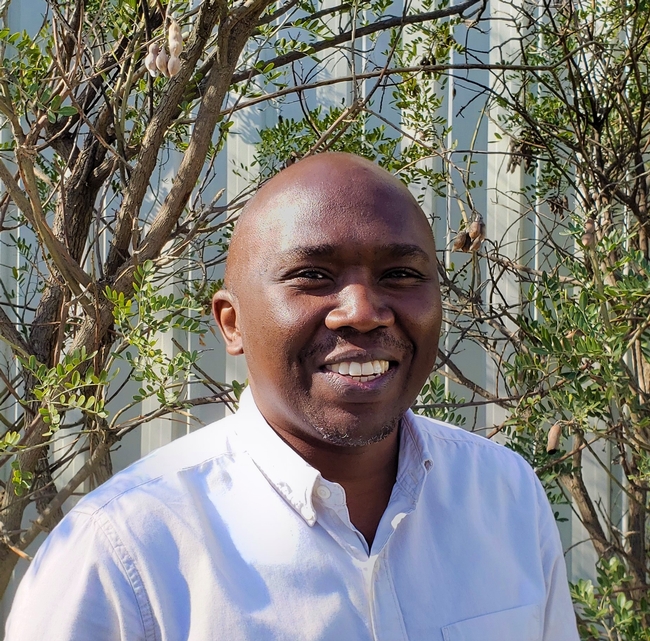
Tobias Oker joined UC Cooperative Extension on Jan. 3 as a soils and irrigation advisor for Kern County.
Prior to joining UC ANR, Oker was an irrigation research engineer at the University of Georgia, Tifton campus for close to four years. At UGA, he collaborated with the state Natural Resources Conservation Service to update the Georgia Irrigation Guide. He also worked on a research project to develop crop water-use curves for apples, peaches, pecans and a grapefruit variety called muscadine.
Oker earned a Ph.D. from Kansas State University, where his doctoral research focused on Mobile Drip Irrigation, a novel technology with a demonstrated potential to improve irrigation efficiency in center pivot systems, the main irrigation method used in the Midwest.
Before attending K-State, he worked in Uganda at the National Agricultural Research Organization as a water management research and extension scientist for three years, and before that as a research assistant for two years.
He earned a M.S. in water science and engineering from IHE Delft, Institute for Water Education in the Netherlands and a B.S. in agricultural engineering from Makerere University in Uganda.
Oker is based at the UCCE office in Bakersfield and can be reached at teoker@ucanr.edu and (661) 868-6218 and on Twitter @TobiasOker.
Andrews named specialty crops advisor 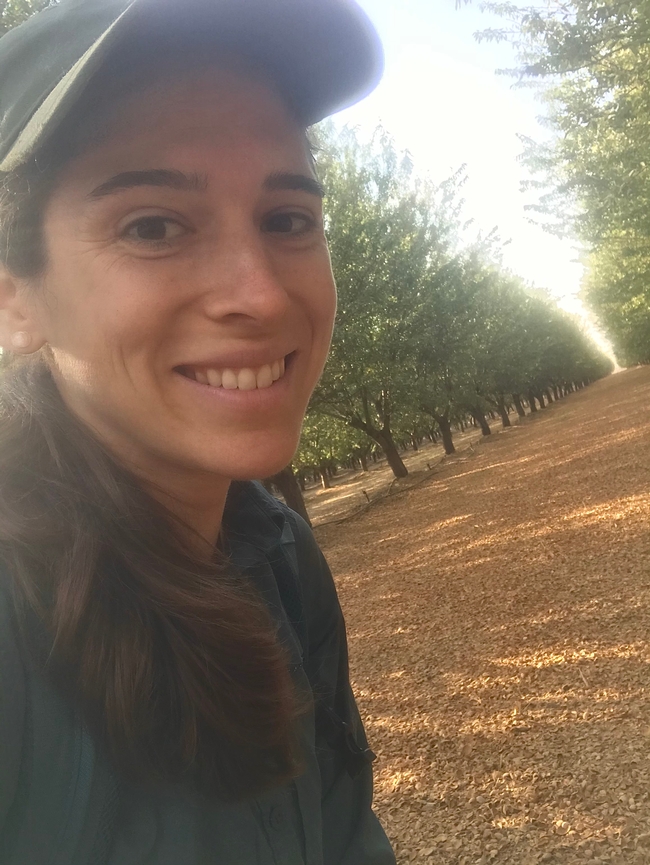
Ellie Andrews joined UC Cooperative Extension on Jan. 3 as a specialty crops advisor for Sonoma, Marin and Napa counties.
Andrews enjoys the interdisciplinary nature of applied agricultural sciences and is excited to assist specialty crop growers with nutrient management, irrigation and integrated pest management. She can provide support for growers who want to implement practices that build soil health, such as organic matter amendment application, cover cropping, and strategies for reducing soil disturbance. She also can assist with variety selection, diversification, crop planning, and climate adaptation strategies.
Originally from Ohio, Andrews earned her bachelor's degree in field ecology with a focus on plant biology at Ohio University. During and after college, she worked on several small-scale certified organic farms where she gained experience with specialty crops such as mixed vegetables, greens, cut flowers, herbs, microgreens and culinary mushrooms.
While working directly with growers for Ohio State Extension, Andrews earned a master's degree in plant health management from The Ohio State University, where the applied interdisciplinary degree program taught her about integrated pest management, plant pathology and soil fertility.
She earned a Ph.D. in horticulture and agronomy at UC Davis. Her doctoral research focused on using organic matter amendments to improve nutrient cycling, soil-plant water dynamics, and soil microbial communities.
Andrews is based at the UCCE office in Santa Rosa and can be reached at eandrews@ucanr.edu.
Benítez joins BFI, UC ANR to study food value chains 
Francisco Benítez Altuna joined UC ANR and Berkeley Food Institute on Jan. 3 as a project scientist.
Benítez will work with a stakeholder advisory group and collaborate on research with BFI-associated faculty on agroecological research and extension programs.
During his academic career, Benítez has developed a strong multidisciplinary background in food value chains. He is interested in understanding the challenges farmers face and the complex interactions between socioeconomic and context characteristics that shape the transition towards sustainable food value chains.
Benítez earned a Ph.D. at Wageningen University and Research in the Netherlands and master's degrees in agribusiness and rural development from the Georg-August University of Göttingen in Germany and the University of Talca in Chile. He earned an engineering degree in agro-industry from the National Polytechnic School in his hometown of Quito, Ecuador.
Benítez is based at the Kearney Agricultural Research and Extension Center in Parlier and can be reached at fjbenitez@ucanr.edu.
- Author: Mike Hsu
David Gonzalves started on Feb. 1 as director for University of California Cooperative Extension in Monterey, San Benito and Santa Cruz counties. UC Cooperative Extension connects communities across California with UC research and science-based solutions through agriculture, natural resources, nutrition and 4-H youth development programs.
Responsible for the overall operation of UCCE educational and applied research programs in the region, Gonzalves also will build and expand partnerships with county and city governments, public agencies and community organizations.
“David brings tremendous expertise in administration, fostering strong relationships, and building effective teams,” said Deanne Meyer, interim associate vice president for programs and strategic initiatives at UC Agriculture and Natural Resources, which administers UCCE statewide. “His track record of engaging local agencies, business partners, stakeholders and community groups will be invaluable as we explore new collaborations to reach and serve more Californians.”
Gonzalves was most recently a campus building official at UC Merced. Beginning his career at the County of Merced as a fire inspector, Gonzalves worked his way up to supervising building inspector and eventually assistant development services director. Then, for the City of Merced, he filled the role of chief building official and ultimately director of development services, leading the city's Building, Planning and Engineering teams. For three years, Gonzalves served as Tuolumne County's Community Resources Agency director.
“David's past experience as an administrator in county government and at UC Merced makes him the ideal candidate for the work we do at UCCE, as he has demonstrated success in being able to successfully negotiate these two worlds,” said Lynn Schmitt-McQuitty, interim director for county Cooperative Extension at UC ANR.
Gonzalves said he looks forward to meeting with county leaders, members of local boards, growers, UC Master Gardener volunteers, 4-H members and community members to learn how UC Cooperative Extension can help meet needs in the area.
“My big picture goal is to allow UCCE advisors, administrative teams and local county leaders to have a coordinated approach to our local challenges and successes,” Gonzalves said. “Our efforts will concentrate on freeing up our research teams' calendars to ensure they can continue producing cutting-edge accomplishments here in the tri-county region.”
Based at the UCCE Monterey County office in Salinas, Gonzalves can be reached at dgonzalves@ucanr.edu or (831) 392-5916.
- Author: Pamela Kan-Rice
University of California Agriculture and Natural Resources continued hiring county-based scientists at a rapid pace over the summer. With increased funding from Gov. Gavin Newsom and the state Legislature, UC ANR recently hired UC Cooperative Extension advisors who bring expertise in wood products, wildfire, wildlife, food systems, urban and small-scale farms, 4-H youth development, pest management, drought, nutrition and environmental horticulture.
UC Cooperative Extension advisors work directly with community members to apply research-based information to improve the lives and livelihoods of Californians.
To see a list of UC Cooperative Extension advisors who have joined in the past few months, visit https://ucanr.edu/About/DirectorySearch/Recent_Hires. The most recently hired advisors are introduced below.
Chen named woody biomass and wood products advisor 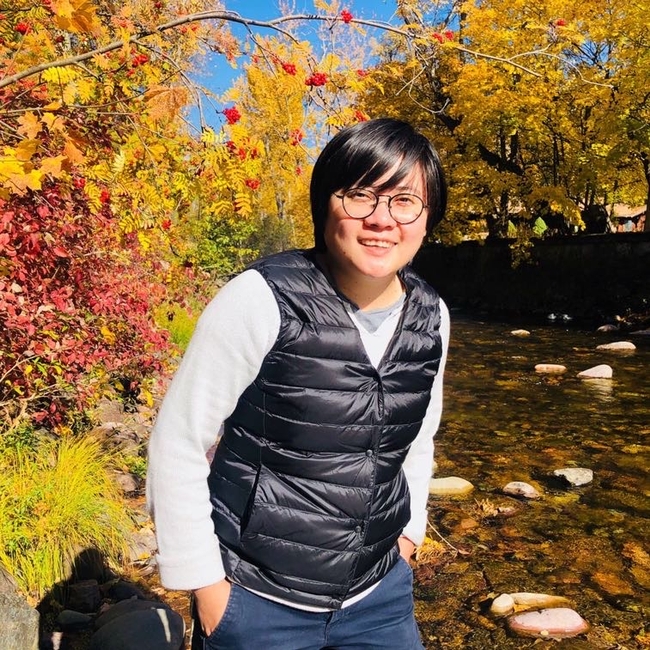
Cindy Chen joined UC Cooperative Extension Sept. 6 as a woody biomass and wood products advisor for the Central Sierra and Alpine and Mariposa counties.
After receiving her bachelor's in social ecology and master's in demography from UC Irvine, Chen completed her Ph.D. in environmental and forest sciences from the University of Washington, specializing in wood products processing and marketing. Chen has worked and lived in all three West Coast states over the past 20 years and she is familiar with the natural environment in the western U.S.
Her multidisciplinary expertise allows her to work on a wide range of projects covering topics such as population forecasting, environmental assessment, woody biomass transportation logistics, the end-of-life treatment of wood products and mass timber production optimization.
Chen has worked with nonprofit organizations, government agencies, research scientists and local stakeholders to investigate the environmental and economic benefits of wood utilization in the construction and energy industries. Her work in evaluating the environmental impacts of Cross Laminated Timber (CLT) production helped prepare for the opening of North America's largest mass timber manufacturing facility in Washington.
In addition to her work in the U.S., Chen also has collaborated extensively with international partners in research projects that explored the global market potential for wood products and bioenergy.
About this position, Chen says, “As the woody biomass and forest products advisor at UC ANR, my goal is to work with the Central Sierra communities in exploring innovative ways to better utilize California's forest resources and biomass, developing biomass processing programs that are appropriate for the region and contributing to local economic development.”
Chen is based in Tuolumne and can be reached at cxnchen@ucanr.edu.
Low brings fire expertise to communities statewide 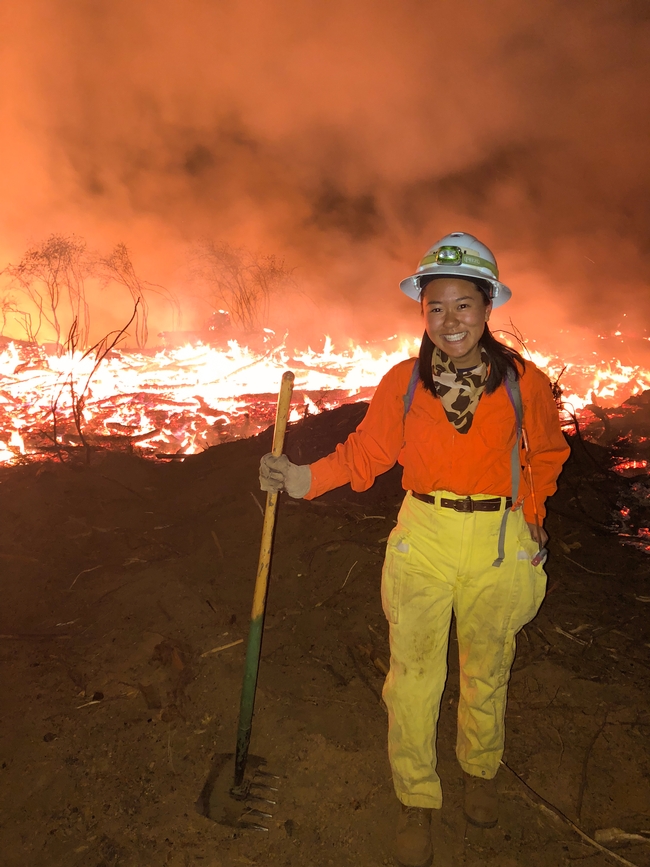
Katie Low, who began as the University of California Cooperative Extension statewide fire coordinator on Sept. 1, will fulfill two important functions for UC ANR's team of fire experts.
First, she will coordinate and partner with UCCE fire advisors throughout California to develop and deliver wildfire-related science and outreach materials for a wide range of communities across the state. Low said encouraging diversity in the network of fire experts and engaged communities will be crucial.
“One of my goals is to help build and maintain a diverse and inclusive community of fire and natural resource professionals,” she said.
Second, based at the UCCE office in Auburn, Low will collaborate with local natural resource professionals and residents in Nevada and Placer counties on projects that bolster community and ecosystem resilience to wildfire and climate change.
“I look forward to working with community groups, land managers and scientists to implement viable fire-resilient management strategies for ecosystems in the region and statewide,” Low said.
Equipped with bachelor's degrees in geography and ecosystems management and forestry, as well as a master's in forestry, all from UC Berkeley, Low brings a wealth of knowledge and a variety of experience.
As a fire and forest ecologist, she studied the impacts of fuels-reduction and forest-restoration treatments on Sierra Nevada mixed-conifer forests. Low also worked as operations coordinator for the California Outdoor Engagement Coalition, and as a forestry aide for the California Department of Forestry and Fire Protection's Forest Biometrics Program.
Low can be reached at (530) 889-7385 and katlow@ucanr.edu; follow her on Twitter @lowseverityfire.
Deak named fire advisor for Mariposa, Fresno and Madera counties 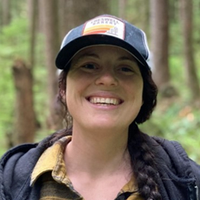
Alison Deak joined UC Cooperative Extension on Aug. 22 as a fire advisor for Mariposa, Fresno and Madera counties. Since she began work, Deak has been focused on conducting a needs assessment and building rapport with community leaders.
Her role as fire advisor will include promoting the use of prescribed fire to help restore fire adapted landscapes. She will also prioritize community education, applied research and partnership building efforts that are based on scientifically informed ways to help communities mitigate, prepare for, and recover from wildfire.
Originally from northeast Ohio where there are no wildfires according to Deak, it was not until she moved to Colorado for college that she learned of their impact.
When the 2012 Waldo Canyon Fire occurred, Deak felt like her playground was burning down so she acted. She began volunteering with the wildfire recovery effort and her career into fire science took off from there.
Deak earned a bachelor's degree in geography and environmental studies from the University of Colorado, Colorado Springs and master's degrees in geography and nonprofit management from the University of Oregon.
Before moving to California and joining UC ANR, Deak worked as a wildland firefighter with the U.S. Forest Service and Bureau of Land Management.
When asked what she is looking forward to most, Deak shared that she is passionate about increasing diversity in the fire science field and, particularly, empowering more women to join. She is eager to help community members prepare for wildfire and mitigate fire risk in a safe and competent manner.
Deak is located at the UC Cooperative Extension office in Mariposa County and can be reached at aldeak@ucanr.edu.
Henry joins UC ANR as food systems advisor for capitol region 
Olivia Henry joined UC ANR on Aug. 15 as regional food systems area advisor for Solano, Yolo, Sacramento, Placer and Nevada counties. Henry will focus on issues related to marketing, resilient supply chains, distribution infrastructure, processing infrastructure, financing models and food waste.
Prior to joining UC ANR, Henry worked in various newsrooms – including CapRadio, the Mendocino Voice, KALW Public Radio, San Francisco Public Press and Mother Jones – in community engagement, membership and communications roles. She also worked with Internews, a media development organization, to conduct information needs assessments in the San Joaquin Valley and Inland Empire regions.
Henry is still involved with community media, and currently serves as the assistant editor of a bimonthly, English and Spanish-language newspaper, “The Ivanhoe Sol,” in rural Tulare County.
She earned her bachelor's degree in journalism from Western Washington University and master's degree in community development from UC Davis. While at Davis, Henry studied models of community- and employee-owned news enterprises, with a focus on how stakeholder ownership can protect journalism as a public good. She also earned a graduate certificate in extension outreach and communication.
Henry said she is excited to be a part of UC ANR, which she has benefitted from as a certified California Naturalist and candidate California Master Beekeeper. She has previously worked at local farms, including a diversified orchard and targeted grazing operation.
Henry is based in Fairfield and can be reached at omhenry@ucanr.edu.
Neas named 4-H advisor for San Mateo, San Francisco counties 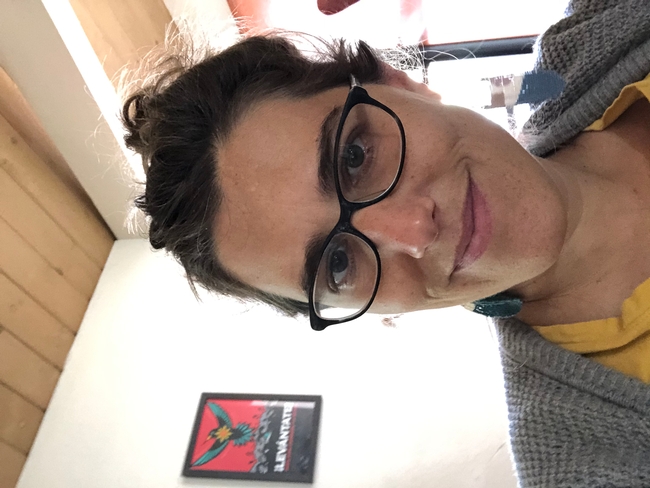
Sally Neas began working as the 4-H youth development program advisor for UC Cooperative Extension in San Mateo and San Francisco counties on Aug. 1.
In her role, Neas incorporates environmental education into youth programs at Elkus Ranch and 4-H community clubs. She is also responsible for conducting research and developing new programs.
Neas has worked in youth development and environmental education for several years. When she first moved to California 12 years ago, she worked for Veggielution Community Farm in San Jose and helped launch their first youth development program.
Since then, she has worked in after-school programming focused on gardening and nutrition in Santa Cruz and has dedicated her time and energy to engaging youth in conversations about climate change.
“I'm interested in building conversations around climate change that focus on culturally relevant and personally meaningful approaches. Not a deficit approach that asks what we're going to give up, but what can we do as a collective,” said Neas.
Neas earned a doctorate in environmental education at UC Davis and a bachelor's in environmental studies from the University of the South in Tennessee.
Neas centered her dissertation on how young people understand and define climate change. Her research relied on oral histories collected from “youth that, historically, are not represented in the climate change space” such as youth of color and queer youth. To capture their stories, Neas initiated a digital storytelling project, drawing on the collaboration between art and science.
“I really felt bothered by not hearing educators adequately address climate change. It felt like a looming elephant in the room, where we either didn't talk about it at all or what we were saying wasn't helpful,” she said.
According to Neas, youth have a moral compass that, unlike in adults, has not been so degraded. Their creativity, compassion and drive inspire Neas to preserve these parts of herself. Moving forward, she is eager to create programs that are inclusive and representative of all youth that she serves.
Neas is based in Half Moon Bay and can be reached at seneas@ucanr.edu.
Norville named fire advisor in Sonoma, Napa and Marin counties 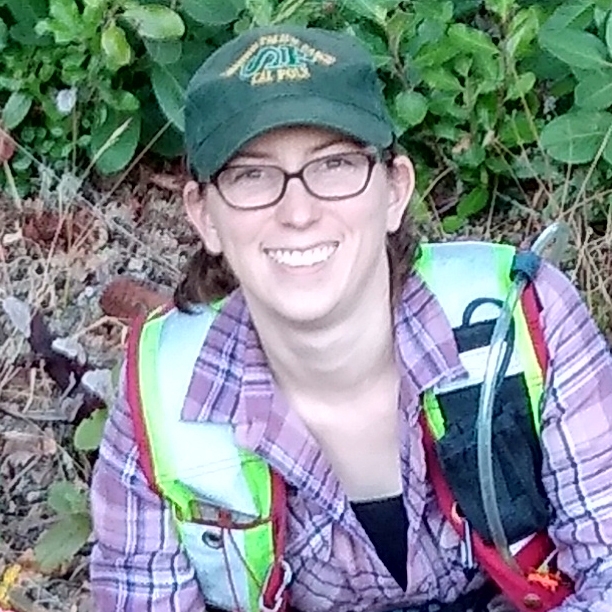
Tori Norville started on Aug. 1 as the new UC Cooperative Extension fire advisor for Sonoma, Napa and Marin counties.
In this capacity, Norville will work with residents and organizations within the wildland-urban interface to encourage and cultivate fire-adapted communities. She aims to provide education and outreach on home hardening, defensible space and the importance of forest and fuel management on the landscape.
While pursuing her bachelor's degree in forestry and natural resources at Cal Poly San Luis Obispo, Norville became interested in “disturbance ecology” – how factors such as disease, insects and fire affect landscapes and environments.
“Many of the forest health problems we are seeing are stemming from a lack of disturbance, which traditionally was fire,” Norville said.
Her understanding of fire and its effects deepened during her master's degree studies in forestry science (also at Cal Poly SLO), as well as through her seven years with CAL FIRE at the Jackson Demonstration State Forest in Mendocino County. She worked as the Registered Professional Forester for its Timber Sales Program, and then the Research and Demonstration Program.
Norville's firsthand experiences from the past few fire seasons have helped shape her goals and approach. She hopes to “work holistically with disturbances” – specifically fire – on the landscape to foster healthy forests and ecosystems that are adaptable and resilient, while also researching the environmental and social aspects of fuel-reduction projects and prescribed fire.
“Hopefully, I can begin to change the perception of fire from something we need to fear, to something we respect,” she said.
Norville, based at the UCCE office in Santa Rosa in Sonoma County, can be reached at trnorville@ucanr.edu.
Atim named UCCE specialist studying crop drought resilience 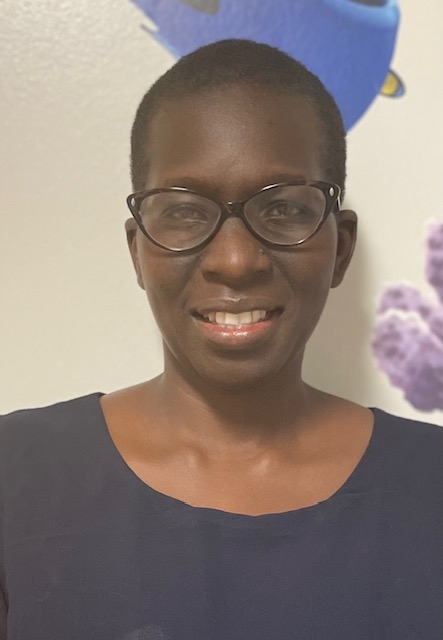
Jackie Atim began working as a UC Cooperative Extension specialist affiliated with UC Merced on July 11, based at Kearney Agricultural Research and Extension Center in Parlier.
Atim's work will include applied research focused on abiotic stress, which includes plant stress caused by extreme temperatures, high salinity, floods, drought or nutrient deficiency. In particular, she will be studying the genetic makeup of sorghum, its resistance to drought and the value it contributes to byproducts such as bioenergy.
California, as Atim explained, is an ideal place to study drought resilience given its semi-arid climate and water challenges. She is hopeful that California will establish sorghum as a climate-smart crop for forage and grain to address the challenges facing water-stressed production systems.
Furthermore, Atim will focus on “transforming science that can be consumed by ordinary farmers and growers alike.”
While Atim understands the importance of research-based decision-making, she also recognizes the challenges that non-academic audiences experience when applying such information. As a start, Atim anticipates collaborating with communications experts to simplify research findings and create visually appealing resources.
Before joining UC ANR, Atim worked as a plant pathologist for the National Agricultural Research Organization based at Mukono Zonal Agricultural Research and Development Institute in Uganda. In addition to pathology, Atim has expertise in plant breeding and entomology.
Atim earned a bachelor's degree in agriculture and education from Kyambogo University in Uganda. She has a master's degree in plant biotechnology from Wageningen University in the Netherlands, and a doctorate in agriculture, plant breeding and entomology from the University of Greenwich in the United Kingdom.
Atim can be reached at jatim@ucanr.edu. Follow her on Twitter @JackieAtim2.
Gyawaly named IPM advisor 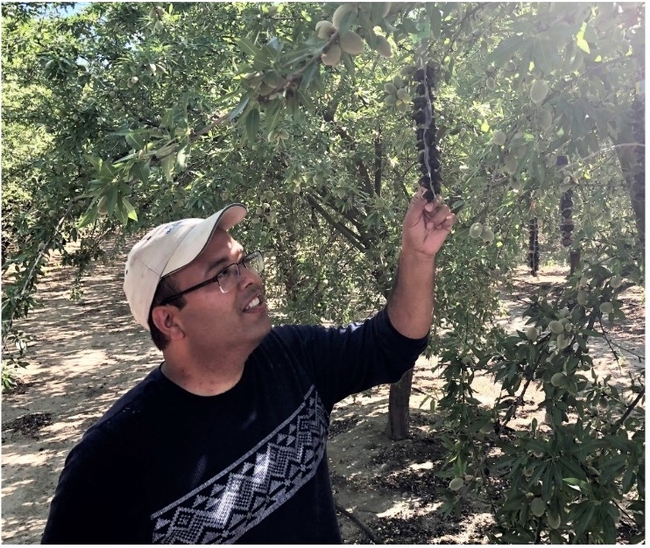
Sudan Gyawaly joined UCCE on July 5 as an area integrated pest management advisor serving Butte, Sutter, Yuba, Glenn, Colusa and Tehama counties.
Prior to becoming an IPM advisor, Gyawaly was an associate specialist at UCCE in Stanislaus County, where he studied tree nut pests, including walnut husk fly, navel orangeworm, and Pacific flatheaded borer. Before that, he was a post-doctoral researcher at North Carolina Agricultural and Technical State University in Greensboro, studying pest management on vegetables and fruit trees on small farms.
In his new role, Gyawaly is learning about the crops and pest situation in the region by talking with growers and other stakeholders. He plans to develop a need-based applied IPM research and extension program for orchards, tree nuts and other crops grown in the region.
He earned an M.S. in entomology from West Virginia University and a Ph.D. in entomology from Virginia Tech.
He earned his undergraduate degree in agriculture in his native Nepal, then worked in rural areas of Nepal for a couple of years, providing sustainable vegetable production and pest management trainings to growers before moving to the United States in 2009 for graduate studies.
Gyawaly is based in Oroville and can be reached at sgyawaly@ucanr.edu.
Martinico named human-wildlife interactions advisor 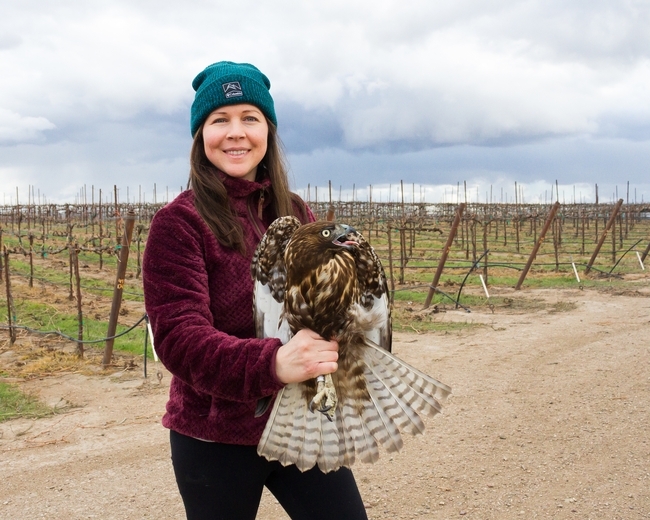
Breanna Martinico joined UC Cooperative Extension on July 5 as a human-wildlife interactions advisor for Napa, Lake and Solano counties. She will work on issues that involve wildlife as agricultural pests as well as beneficial species. To learn about priority issues for the area, she will be conducting a needs assessment.
Martinico is a wildlife biologist and ecologist, specializing in ornithology. Her past research addressed the role of birds on farms as pests and pest control agents. She has worked on projects investigating the important role farmland plays as habitat for California birds. In other work with the USDA Western Sustainable Agriculture Research and Education program, she investigated the effects of agricultural land-use and pest management practices on raptor ecology and conservation.
“I am compelled by the co-existence and mutual benefits of humans and wildlife in agroecosystems and committed to working to find solutions that benefit both people and wildlife,” Martinico said. “I am excited to be part of UC ANR where I can develop a research and extension program that has the power to increase knowledge and adoption of management practices that promote ecological sustainability and increase farm viability in California.”
She earned a B.S. in wildlife, fish and conservation biology and M.S. in avian sciences, and has nearly completed her Ph.D. in ecology, all from UC Davis.
Martinico is based in Napa and can be reached at bmartinico@ucanr.edu.
Padasas named nutrition and health advisor 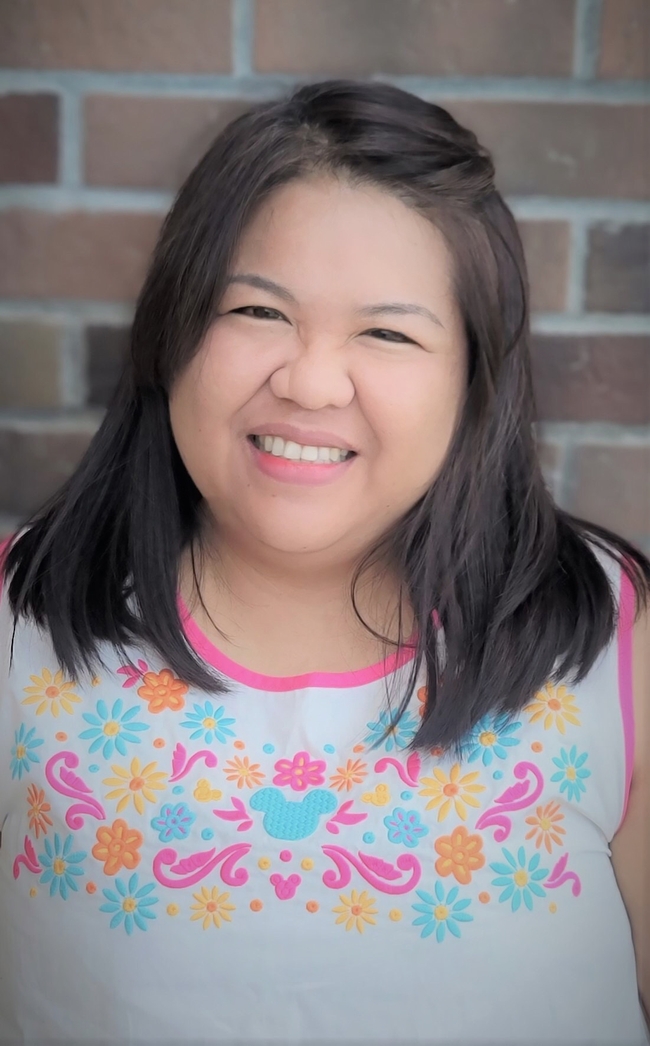
Irene Padasas started as UC Cooperative Extension community nutrition and health advisor for Tulare, Kings, Madera and Fresno counties on June 13.
Padasas will design her education and research programs for communities based on their priority needs within the broad areas of healthy lifestyles, health equity, food, nutrition, water security and safety, and climate change and health.
As part of UC Agriculture and Natural Resources' work to promote healthy families and communities, Padasas also will support the efforts of the Expanded Food and Nutrition Education Program in California and the Cal Fresh Healthy Living, University of California Nutrition Education Program.
After earning a bachelor's in special education at the University of the Philippines Diliman, and a master's in developmental psychology from the Ateneo de Manila University, Padasas received her Ph.D. in human sciences – with a specialization in global family health and well-being – from the University of Nebraska at Lincoln.
In Nebraska, Padasas played a significant role in extension programs that promote positive and healthy child and adolescent development, such as co-developing curriculum for UpStarts, a program that provides youth entrepreneurship and STEAM (Science, Technology, Engineering, Arts and Math) education for high school students in rural areas.
She also led the analyses of qualitative data from the Ecological Approach to Family Style Dining, a research intervention program that aims to support young children's health and nutrition in early childcare centers subsidized by USDA's Child and Adult Care Food Program.
Padasas' current research centers on social and cultural factors that shape the quality of life and well-being of families.
“To serve our communities more effectively as an advisor, I'm focused on exploring the role of culture in health communication to better understand adoption and acceptance of health and nutrition education programs in the community,” Padasas said.
Padasas is based at the UCCE office in Tulare and can be reached at iopadasas@ucanr.edu.
Goncalves named UCCE diversified agriculture advisor for Lake and Mendocino counties 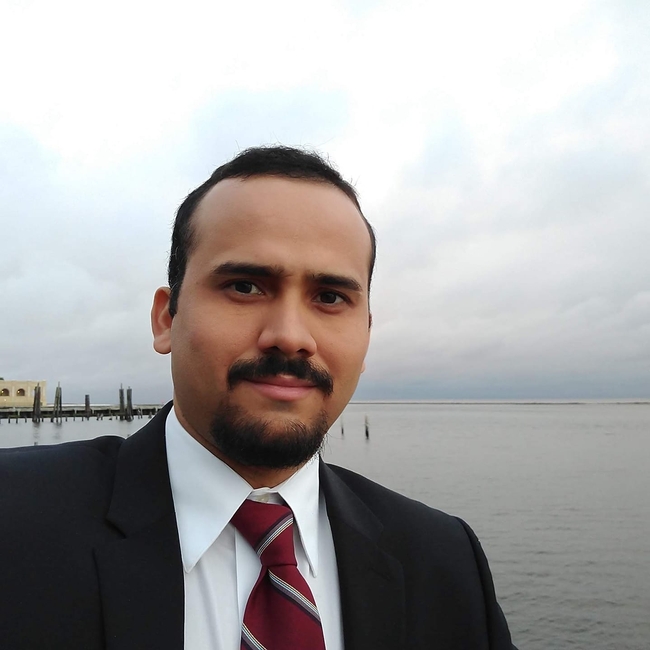
Clebson Goncalves joined UC Cooperative Extension on July 1 as a diversified agriculture advisor serving Lake and Mendocino counties.
Prior to moving to California, Goncalves was a postdoctoral researcher working on the management of turfgrass and ornamental crops for a USDA-SCRI project at the School of Plant and Environmental Sciences at Virginia Tech.
He has a bachelor's degree in agronomy (focused on plant pathology) and a master's degree and Ph.D. in agronomy sciences (plant production/ weed science) from Brazil, as well as an additional master's degree in crop and soil science (turfgrass/weed science) from Auburn University. He led field, greenhouse and lab research with a broad focus on plant production, crop protection and weed sciences.
Goncalves' current research centers around diversified agricultural farms, including vegetables, fruit and nut crops. He is also interested in integrated weed management practices exploring chemical and organic options, improving pesticide application technology, drone use for data collection, pesticide application and pollinator-serving plant communities.
Goncalves is based in Lakeport and can be reached at goncalves@ucanr.edu. Follow him on Twitter @clebson_g.
Shogren named UCCE environmental horticulture advisor 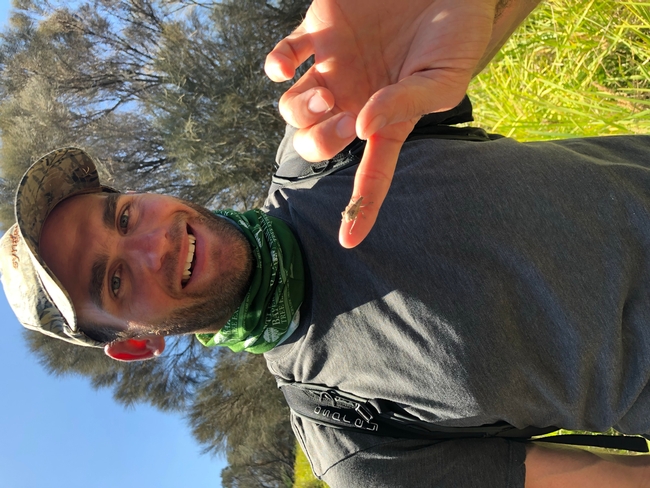
Chris Shogren joined UC ANR on June 5 as the environmental horticulture advisor for UC Cooperative Extension in Los Angeles County.
Shogren described his new role as “giving back to the community.” While he has more experience “growing plants than playing with insects,” Shogren's expertise includes all aspects of horticulture such as entomology, pathology, water use and more.
He earned a bachelor's degree in horticulture and agricultural business from Cal Poly San Luis Obispo, and a doctorate in entomology from UC Riverside.
Much of what he knows not only comes from his formal academic training, but what he learned from his parents. Shogren grew up in Hemet, 25 miles outside of Palm Springs, and spent his childhood working at his parents' wholesale nursery. Building rapport with nurseries comes naturally to Shogren and he has been advising them since his days as a Ph.D. student.
Early in his career, Shogren worked on horticulture for Disneyland before joining the Citrus Research Board, where he focused on biocontrol rearing. Prior to joining UC ANR, Shogren mass reared fruit flies for U.S. Department of Agriculture research.
As an advisor, Shogren's top priority is to develop his program by first understanding the local issues and the key players that are addressing them such as advisors, researchers and industry groups. He believes that doing so will paint a clear picture of where and how he can be the most effective.
Shogren is based out of the UC Cooperative Extension office in Los Angeles County and can be reached at cjshogren@ucanr.edu.
Singh joins UCCE Central Sierra as local food systems advisor 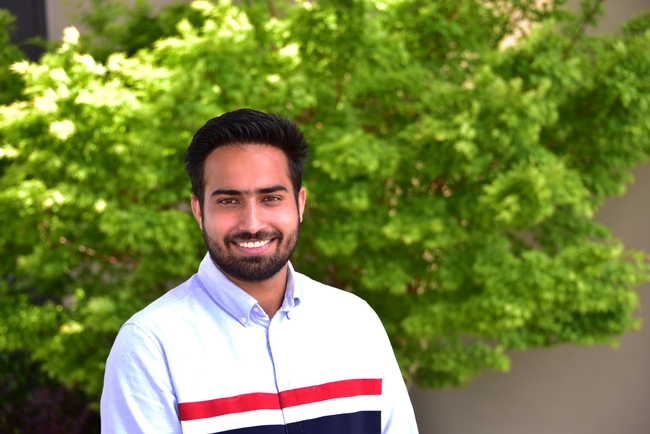
Hardeep Singh joined UCCE Central Sierra as a local food systems advisor on June 1.
He transferred from the UCCE Fresno office where he worked as an assistant specialist in small farms and specialty crops. Singh, who is from Punjab, India, worked closely with Southeast Asian small farmers, African American farmers, Latino farmers and Punjabi farmers. Much of his work focused on healthy soil practices, the Irrigated Lands Regulatory Program, Coronavirus Food Assistance Program, and UC San Francisco COVID-19 Equity Project since 2020. He also worked as a vineyard operations intern with UCCE Fresno in the summer of 2019.
Singh holds a master's degree in plant science from California State University, Fresno with a distinction as Dean's Graduate Medalist. He also holds a bachelor's degree in agriculture from Punjab Agriculture University, Ludhiana, in India.
His research background includes crops such as moringa, cover crops, wine grapes, almonds, pistachios and citrus. With the exception of pistachios, Singh also has research experience in irrigation scheduling and nutrition management for these same crops.
Singh is interested in developing crop coefficients, studying nitrogen dynamics in specialty crops, and reducing production costs for small farms, which aligns with his goal of reducing poverty by engaging with socially disadvantaged communities and moving agriculture toward greater self-sustainability.
Singh is based in San Andreas and can be reached at hdsing@ucanr.edu and (559) 579-6065.
Mukherjee named urban and small farms advisor 
Amrita Mukherjee joined UC ANR on April 1 as an urban agriculture and small farms advisor serving Los Angeles, San Bernardino, Riverside and Orange counties.
Mukherjee's priority is to understand small farms' practices and needs, and to identify opportunities for improvement and/or collaboration. One challenge that Mukherjee is eager to overcome is getting information to farmers in a timely and organized manner.
“There's so much information out there and it's hard to know who is doing what,” she said. By implementing a communication system, Mukherjee believes that supporting small farms will become more efficient.
Originally from Bangladesh, Mukherjee grew up in a family of farmers and understands the struggles farmers encounter as laborers and as a business. Her upbringing inspired her to not only pursue a career in agriculture, but to alleviate the hardships that often burden farmers.
Previously, Mukherjee worked for the International Rice Research Institute where she examined flash flood risk-management in her homeland. She also worked for the Horticulture Innovation Lab management team at UC Davis as an assistant specialist in Bangladesh, focused on nutrition impacts of horticultural innovations.
Mukherjee earned a bachelor's degree in agriculture from Khulna University, a master's degree in biotechnology from Bangladesh Agricultural University, and a master's degree in horticulture, plant biology and post-harvest physiology from Kansas State University.
While she has dedicated the first few months of her role to networking, Mukherjee feels that building rapport with small-scale farmers is an ongoing process that is crucial to her role as an advisor.
When asked what she is most excited about, Mukherjee said that she wants to help farmers grow – not just their crops, but their business strategy and network. “I don't want to be a supervisor, I want to be a connector,” explained Mukherjee.
Mukherjee is based at the UC Cooperative Extension office in Highland in San Bernardino County and can be reached at amukherjee@ucanr.edu.
Sope connects journalists with UC ANR experts 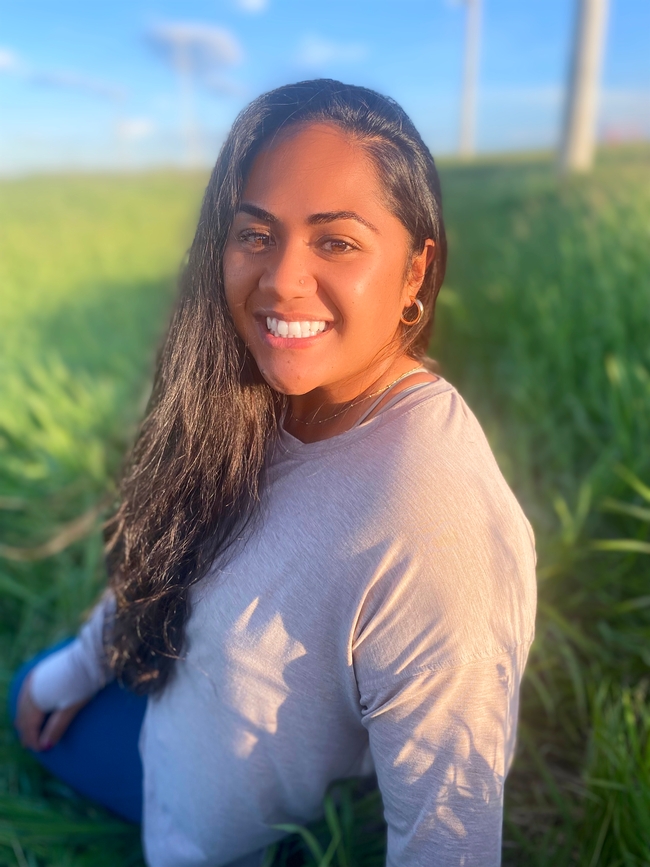
Saoimanu “Saoi” (rhymes with Maui) Sope joined UC ANR Strategic Communications on June 7 as a communications specialist to help journalists connect with UC ANR experts.
Prior to joining UC ANR, Sope worked in tobacco control policy for the state of California with a focus on effective messaging. Early in her career, she worked as a communications specialist for Driscoll's in Watsonville.
Sope earned a bachelor's degree in film and digital media and community studies from UC Santa Cruz and a Master of Public Health degree in environmental health science and certificate in toxicology from Columbia University Mailman School of Public Health.
Based at UC South Coast Research and Extension Center in Irvine, Sope can be reached at ssope@ucanr.edu. Follow her on Twitter @saoimanu.



